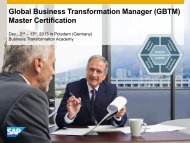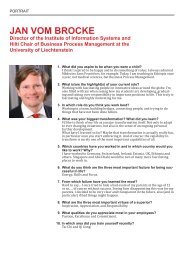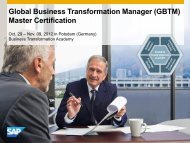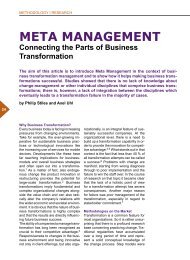Digital Enterprise Transformation - 360° Journal
Digital Enterprise Transformation - 360° Journal
Digital Enterprise Transformation - 360° Journal
- No tags were found...
You also want an ePaper? Increase the reach of your titles
YUMPU automatically turns print PDFs into web optimized ePapers that Google loves.
METHODOLOGY | RESEARCHPermanent BTM ac-vi-es, e.g. maintain change capability Transforma-on program Transforma-on program Permanent EAM ac-vi-es, e.g. maintain EA models 26Fig. 1: Majorprocesses anditerationsIncremental change Incremental change Incremental change Incremental change Incremental change Incremental change = Itera-ons Typical examples are:−−Previous unsuccessful or failed transformationinitiatives provide strongguidance to future roadmap decisions.−−BTM (Process and OrganizationChange Management) provides keyinputs to the “to-be” state of business,application and technology architecturephases in EAM to ensure thatlessons from the past are taken intoconsideration.−−BTM (Strategy Management) provideskey input to the “to-be” BusinessModel used in the developmentof “to-be” states in EAM.Figure 1 shows that both EAM and BTMconsist of a permanent process part (darklong arrows) and of temporary activitieswhich they provide within single transformationprograms or incremental changes(bright small arrows). For EAM, the permanentprocess is of larger importancebecause it includes the maintenance of“as-is” and “to-be” EA models and principlesas the main focus of enterprise architects.For BTM, the permanent task isthe maintenance of sustainable transformationcapabilities, which is regarded tobe more lightweight, while the dominantpart is the support of actual transformationprograms and projects.But even with the best plans, in reality itis impossible to get everything right fromthe beginning and in one go. Experienceshows that both methods ought to be appliedby means of fulfilling small packagesand following iterative cycles (illustratedby the round arrows in figure 1). Moreprecisely, there are three major reasonsfor these iterations:1. Stakeholders might lose focus ormight be hard to convince that the farawaytransformation success will beachieved. Showing early benefits fromfulfilling small packages and the firstiterations helps to convince and motivatethe stakeholders and to keep thetransformation running.2. Since many changes happen simultaneously,long-range planning needs tobe flexible in order to adapt to a changingcontext like new legislation or customerdemands.3. Occurring problems during the implementationof the transformation can behandled at short notice and the solutionscan be used as input for the followingiterations, improving organizationallearning.From the comparison of focus areas,problems, and processes we move on toexamining the goals of EAM and BTM.













